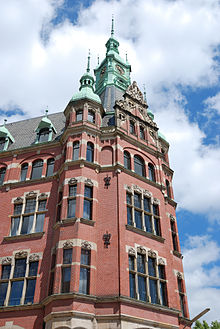Speicherstadt
| Speicherstadt | |
|---|---|
 View at night, 2016 | |
 | |
| General information | |
| Type | warehouse district |
| Architectural style | Gothic Revival |
| Location | Hamburg, Germany |
| Coordinates | 53°32′36″N 9°59′31″E / 53.54333°N 9.99194°E |
| Construction started | 1883 |
| Completed | 1927 |
| Opened | 1888 |
| Owner | Free and Hanseatic City of Hamburg |
| Dimensions | |
| Other dimensions | 1,500 m × 250 m |
| Technical details | |
| Material | red brick |
| Size | 26 ha (64 acres) |
| Floor area | 630,000 m2 (6,800,000 sq ft) |
| Design and construction | |
| Architect(s) | Carl Johann Christian Zimmermann |
| Engineer | Franz Andreas Meyer |
| Official name | Speicherstadt |
| Type | cultural |
| Criteria | iv |
| Designated | 2015 |
| Part of | Speicherstadt and Kontorhaus District with Chilehaus |
| Reference no. | 1467 |
| Property | 26.08 ha (64.4 acres) |
| Buffer zone | 56.17 ha (138.8 acres) |

The Speicherstadt (German pronunciation: [ˈʃpaɪ̯çɐˌʃtat], literally: 'City of Warehouses', meaning warehouse district) in Hamburg, Germany, is the largest warehouse district in the world where the buildings stand on timber-pile foundations, oak logs, in this particular case.[1] It is located in the port of Hamburg – within the HafenCity quarter – and was built from 1883 to 1927.
The district was built as a
Geography
The Speicherstadt is located in the port of Hamburg. It is 1.5 km (0.93 mi) long and interlaced by loading canals (Low German: Fleets).
History
From 1815, the independent and sovereign city of Hamburg was a member of the German Confederation – the association of Central European states created by the Congress of Vienna – but not a member of the German Customs Union.
Following the
In 1883, to clear space for the new port area, the demolition of the Kehrwieder and Wandrahm area began and more than 20,000 people needed to be relocated. The construction was completed before the start of World War I, managed by the Freihafen-Lagerhaus-Gesellschaft (the predecessor of the Hamburger Hafen und Logistik AG), which was also responsible for the subsequent operation.
After the destruction of about half of the buildings in
Architecture


The warehouses were built with different support structures, but Franz Andreas Meyer created a Neo-Gothic red-brick outer layer with little towers, alcoves, and glazed terra cotta ornaments. The warehouses are multi-storey buildings with entrances from water and land.[8] One of the oldest warehouses is the Kaispeicher B of the International Maritime Museum.

Use
The Speicherstadt is a major tourist attraction in Hamburg and is the focus of most of the harbor tours.[11] There are several museums, like the Deutsches Zollmuseum (German Customs Museum), Miniatur Wunderland (a model railway), and the Hamburg Dungeon. The Afghan Museum was also located here, but closed in 2012.[12]
The buildings are also used as warehouses. As of 2005, the companies in the Speicherstadt handled one third of the world's carpet production, and other goods including cocoa, coffee, tea, spices, maritime equipment, and electronics.[8]
See also
References
- ^ "Speicherstadt". Lonely Planet. Archived from the original on 8 April 2018. Retrieved 24 December 2017.
- ^ "Speicherstadt and Kontorhaus District with Chilehaus". UNESCO World Heritage Centre. United Nations Educational, Scientific. Retrieved 18 September 2022.
- ^ Planung und Finanzierung der Speicherstadt in Hamburg ,by Frank M. Hinz; publ. LIT Verlag Münster, 2000; page 45
- ^ Constitution of the North German Federation //de.wikisource.org/wiki/Verfassung_des_Norddeutschen_Bundes Retrieved Dec 2017
- ^ Hamburg and the Freeport - Economy and Society 1888–1914, by Peter Borowsky, publ Hamburg University Press, Hamburg, 2005; p. 114
- ISBN 3-8319-0179-1.
- ^ "Speicherstadt Hamburg Entwicklungskonzept (German)" (PDF). Hamburg Behörde für Stadtentwicklung und Umwelt. April 2012. Retrieved 5 July 2015.
- ^ ISBN 3-8319-0179-1.
- ^ "Gesetz über die räumliche Gliederung der Freien und Hansestadt Hamburg (RäumGiG) [Act of the areal organisation]" (in German). 2006-07-06. Archived from the original on 2007-08-13. Retrieved 2009-10-30.
- ISBN 978-3-593-38547-1.
- ^ "Speicherstadt". Hamburg Tourismus GmbH. Retrieved 24 December 2017.
- ^ "Afghanistan Museum Hamburg". Dark Tourism. Retrieved 24 December 2017.
Bibliography
- Batz, M. (2002). "Urbane Light Germany Speicherstadt, Hamburg, the largest historical warehouse complex in the world, has become a softly-glowing night-time panorama". International Lighting Review (12): 14–19. OCLC 193350885.
- Lawrenz, Dierk; von Borstel, Christiane (2008). Die Hamburger Speicherstadt (in German). Freiburg, Br: EK-Verlag. ISBN 978-3-88255-893-7.
- Meyn, Boris (2003). Die rote Stadt: ein historischer Kriminalroman (in German). Reinbek: ISBN 978-3-499-23407-1. A historical detective story.
- Lange, Ralf; Hampel, Thomas (2004). Speicherstadt und HafenCity: zwischen Tradition und Vision (in German). Hamburg: Elbe-und-Flut-Ed., Hampel und Hettchen. ISBN 978-3-7672-1440-8.


